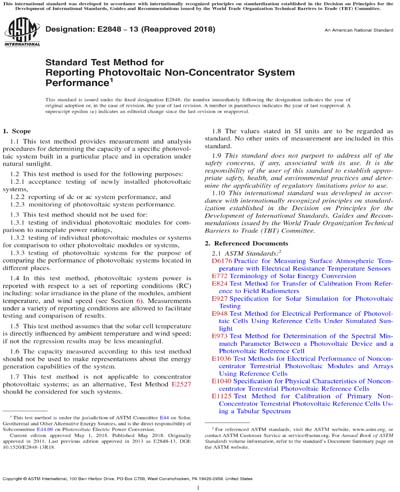Historical
ASTM E2848-13(2018)
Standard Test Method for Reporting Photovoltaic Non-Concentrator System Performance
1.1 This test method provides measurement and analysis procedures for determining the capacity of a specific photovoltaic system built in a particular place and in operation under natural sunlight.
1.2 This test method is used for the following purposes:
1.2.1 acceptance testing of newly installed photovoltaic systems,
1.2.2 reporting of dc or ac system performance, and
1.2.3 monitoring of photovoltaic system performance.
1.3 This test method should not be used for:
1.3.1 testing of individual photovoltaic modules for comparison to nameplate power ratings,
1.3.2 testing of individual photovoltaic modules or systems for comparison to other photovoltaic modules or systems,
1.3.3 testing of photovoltaic systems for the purpose of comparing the performance of photovoltaic systems located in different places.
1.4 In this test method, photovoltaic system power is reported with respect to a set of reporting conditions (RC) including: solar irradiance in the plane of the modules, ambient temperature, and wind speed (see Section 6). Measurements under a variety of reporting conditions are allowed to facilitate testing and comparison of results.
1.5 This test method assumes that the solar cell temperature is directly influenced by ambient temperature and wind speed; if not the regression results may be less meaningful.
1.6 The capacity measured according to this test method should not be used to make representations about the energy generation capabilities of the system.
1.7 This test method is not applicable to concentrator photovoltaic systems; as an alternative, Test Method E2527 should be considered for such systems.
1.8 The values stated in SI units are to be regarded as standard. No other units of measurement are included in this standard.
1.9 This standard does not purport to address all of the safety concerns, if any, associated with its use. It is the responsibility of the user of this standard to establish appropriate safety, health, and environmental practices and determine the applicability of regulatory limitations prior to use.
1.10 This international standard was developed in accordance with internationally recognized principles on standardization established in the Decision on Principles for the Development of International Standards, Guides and Recommendations issued by the World Trade Organization Technical Barriers to Trade (TBT) Committee.
Content Provider
ASTM International [astm]






